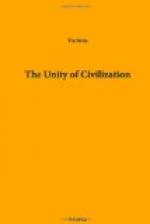Along the Arctic seaboard, homogeneous from Behring Strait nearly to the North Cape, we have the frozen tundra region, with a characteristic tundra culture; pushed now far north since Europe mellowed into a habitable world, but formerly widespread about the skirts of the shrinking ice-sheet. Here we hunt large animals and sea-shore beasts, and trap small-deer very ingeniously; we fish in the large northward-flowing rivers; and eventually (heaven knows after how long, or how far back from now) we borrowed a notion, probably from pastorals imprudently straying too far along those northward river-lanes through the forests, and domesticated our best of beasts, the reindeer; stealing a march here on our Alaskan cousins, who call them caribou and treat them so: they had no pastorals on the prairie southward to teach them otherwise, and when the Russians came and brought reindeer over from Asia, the silly fellows turned them loose and hunted them till they had eaten them all.
South of the tundra, the Great Northern Woodland encircles the planet, interrupted only by the treeless sea. Here too we hunt, and trap, and eat berries of the undergrowth, like Algonkins or Tacitean Germans, many of whom had no more skill in cattle than Algonkins. But we have not the place to ourselves, like the tundra folk and the Algonkins. Our forest world is in ever-present danger of disintegration, and our wood-craft with it. Fond folk with tame animals (poor sport, both of them, for sportsmen like us) come blundering in off the parkland away south, up the grassy glades, trampling undergrowth and scaring the game. People are saved from all that ‘over there’, because no one can tame the prairie buffalo and drive him over the hunting grounds; some sport, too, the prairie buffalo! And worse still, there are the people who come hacking and burning our great trees, and tearing up the turf and underwood, and all to plant their fancy grasses with the fat seeds, that the deer like to browse over; and that is the only thing to make those people show fight, if we or the deer go among their fat-grass plots. Those people come up, too, from the south and the south-east, and have to go back thither for seed if their sowings fail. Of course they like their animals tame, like the other fellows; but the grasses are their first string, as we bow-men say.
Southward, enveloping the Alpine ridges, except where the snow peaks perforate its carpet covering, the Woodland changes its character, rather than gives place to anything fresh along the shores of the Lake Region of the Old World. Here and there, in detached plateaux enfolded among the ranges (like the Salt Lake basin and the Shoshonean plateaux in America), there are isolated grassy plains, repeating on a smaller scale the great grassland which skirts the Black Sea and the Caspian. Examples are the heart of Spain and of Asia Minor, and the miniature grasslands of the Balkan Peninsula, such as Thessaly and Eastern Thrace.




